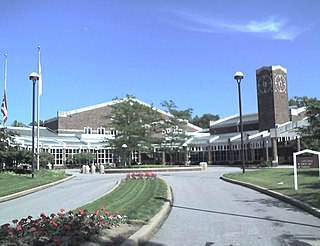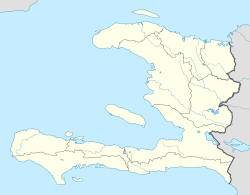
Bethel is the largest community on the Kuskokwim River, located approximately 50 mi (80 km) upriver from where the river flows into Kuskokwim Bay. Bethel is the largest community in western Alaska and in the Unorganized Borough, as well as the ninth largest in the state, with a population of 6,080 as of the 2010 Census.

Kotzebue or Qikiqtaġruk is a city in the Northwest Arctic Borough in the U.S. state of Alaska. It is the borough's seat, by far its largest community and the economic and transportation hub of the subregion of Alaska encompassing the borough. The population of the city was 3,201 as of the 2010 census, up from 3,082 in 2000. The city has an All-America City award

Slana is a census-designated place (CDP) in the Valdez-Cordova Census Area in the Unorganized Borough of the U.S. state of Alaska. As of the 2010 census, the population of the CDP was 147, up from 124 in 2000.

Allakaket is a second class city in the Yukon-Koyukuk Census Area of the Unorganized Borough of the U.S. state of Alaska. The population was 105 at the 2010 census.

Arkadelphia is a city in Clark County, Arkansas, United States. As of the 2010 census, the population was 10,714. The city is the county seat of Clark County. It is situated at the foothills of the Ouachita Mountains. Two universities, Henderson State University and Ouachita Baptist University, are located there. Arkadelphia was incorporated in 1857.

Carthage is a city in Hancock County, Illinois, United States. The population was 2,605 as of the 2010 census, down from 2,725 in 2000. It is the county seat of Hancock County. Carthage is best known for being the site of the 1844 murder of Joseph Smith, founder of the Latter Day Saint movement.

Rochester is a city founded in 1854 in the U.S. state of Minnesota and is the county seat of Olmsted County located on the Zumbro River's south fork in Southeast Minnesota. It is Minnesota's third-largest city and the largest city located outside the Minneapolis-St. Paul Metropolitan Statistical Area. As of 2018, the Rochester metropolitan area had a population estimated at 219,802. According to the 2010 United States Census the city had a population of 106,769. The U.S. Census Bureau estimated that the 2019 population was 118,935. It is the home of the Mayo Clinic and a major IBM facility, one of the company's largest at its peak. The city has long been rated as one of the best places to live in the United States by multiple publications such as Money.

Poplar is a city in Roosevelt County, Montana, United States. The population was 810 at the 2010 census.

Solon is a city in Cuyahoga County, Ohio, United States, and is a suburb of Cleveland. It is part of Northeast Ohio's combined Cleveland-Akron-Canton metropolitan area, the 15th-largest Combined Statistical Area in the country. According to the 2010 census, the city population was at 23,348.

Ohangwena is one of the fourteen regions of Namibia, its capital is Eenhana. The northern and western parts of the region are the most densely populated of this essentially subsistence agricultural region in which small scale mahangu cultivation and the keeping of cattle form the predominant activities. Although the region depends on rain fed agriculture, other crops can be established under intensive cultivation.

The University of California Davis School of Medicine is one of six University of California medical schools in the state of California, and is associated with University of California, Davis.

Oak Ridges is an unincorporated community in Ontario, Canada, and has been part of Richmond Hill since 1971. It forms the northern portion of the municipality's boundary, where it borders Aurora. Located about 20 km north of Toronto, it has a population of 38,140 (2016). The town developed around Lake Wilcox, the largest lake in the area, and has continued to expand slowly since its annexation by the Town of Richmond Hill. In the 1990s, Oak Ridges experienced moderate growth, which spurred environmental action by numerous organizations. Population has grown significantly as a result of development initiatives along Bayview Avenue. The Oak Ridges Community Center was built and completed in June 2012 to accommodate community demand.

Khayelitsha is a partially-informal township in Western Cape, South Africa, on the Cape Flats in the City of Cape Town. The name is Xhosa for OurNew Home. It is reputed to be the largest and fastest-growing township in South Africa.

Centre-Sud is one of Burkina Faso's 13 administrative regions. The population of Centre-Sud was 638,379 in 2006 and was estimated at 722,631 in 2011. The region's capital is Manga. Three provinces-Bazèga, Nahouri, and Zoundwéogo, make up the region.

Mangadu is a south-western part of Chennai, India. It is located in Kundrathur Taluk. Literally meaning a mango forest, Mangadu is about 18 km from Chennai Central railway station, 14 km from Chennai International Airport and 13 km from CMBT. Mangadu comes under Chennai city limits. Mangadu is famous for its Kamakshi Amman temple. It is believed that the great Hindu saint Adi Sankara visited this temple and installed the Ardha Mahameru Yantra.

The Faculty of Dentistry is one of the constituent faculties of McGill University. It became established as a constituent of McGill University in 1904 as the McGill Dental School, a department in the McGill University Faculty of Medicine until becoming its own faculty in 1920. The faculty is closely affiliated with the Montreal General Hospital, Jewish General Hospital, Montreal Children's Hospital, and McGill University Faculty of Medicine.

North Lakes is a suburb of the Moreton Bay Region, Queensland, Australia. North Lakes is located approximately 26 km north of the Brisbane central business district. At the 2016 census the suburb recorded a population of 21,671.

Saint-Louis-du-Sud is a commune in the Aquin Arrondissement, in the Sud department of Haiti. It has 59,042 inhabitants.
Ecuador contains three distinct climatic regions: Tropical, Highland or Sierra, and Amazon rain forest. The health conditions of this country vary according to these regions. In the sierras, in cities such as Quito or Cuenca where most Ecuadorians live, health conditions most commonly associated with the tropics do not exist. For example, the types of mosquitoes which carry malaria and dengue fever cannot live at altitudes above 2300 meters as is the case in virtually all of the sierras. While there does not seem to be general agreement in the medical community about the prevalence of altitude-related conditions, some visitors to the highlands may experience symptoms. The lower atmospheric pressure of the sierras affects some individuals profoundly with difficulty in breathing, nausea and dizziness but these conditions are typically not of long duration and require a period of reduced activity and conservative eating and drinking for acclimatization. Ecuadorians living most of their lives in the sierras commonly require a brief period of re-adjustment after living at sea level for prolonged periods of time. In the low-lying coastal regions and in the Amazonian region, the predictable diseases of those climates exist. Malaria, for example, is according to UN sources no longer epidemic in Ecuador. Nor is Dengue Fever. According to WHO data on confirmed cases of malaria, Ecuador had 8464 cases per 100,000 population in 2007 and 544 cases in 2012. Changes in living conditions and health care appear to have had a significant effect on this condition. The potential for these diseases does exist but mostly in isolated, economically-depressed areas of the Amazon and seacoast. Many do not realize that dengue-infected mosquitoes exist in the southeastern US but do not infect inhabitants on a widespread basis. Life expectancy is approximately that of the US.

Substance use disorder (SUD) is the persistent use of drugs despite substantial harm and adverse consequences. Substance use disorders are characterized by an array of mental/emotional, physical, and behavioral problems such as chronic guilt; an inability to reduce or stop consuming the substance(s) despite repeated attempts; driving while intoxicated; and physiological withdrawal symptoms. Drug classes that are involved in SUD include: alcohol; caffeine; cannabis; phencyclidine and other hallucinogens, such as arylcyclohexylamines; inhalants; opioids; sedatives, hypnotics, or anxiolytics; stimulants; tobacco; and other or unknown substances.



















